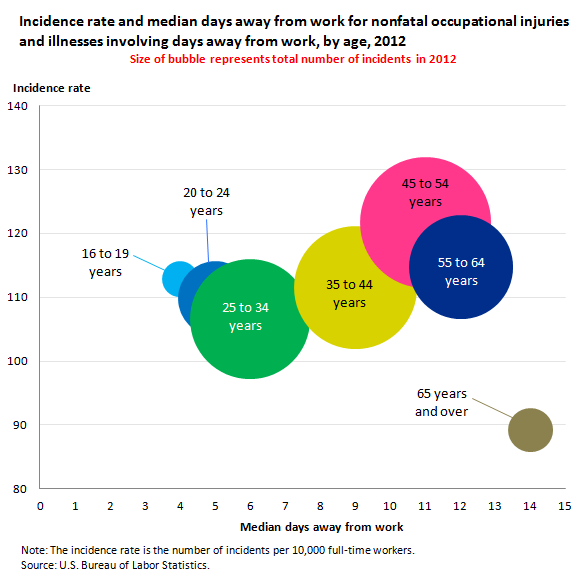An official website of the United States government
 United States Department of Labor
United States Department of Labor
The rate of nonfatal occupational injuries and illnesses requiring days away from work to recuperate was 112 cases per 10,000 full-time workers in 2012, down from 117 cases in 2011. The median days away from work—a key measure of severity of injuries and illnesses—was 9 days in 2012. Workers age 65 and older had the lowest incidence rate in 2012 at 89 cases per 10,000 full-time workers, but they required the longest time away from work to recover, a median of 14 days.

| Age | Incidence rate | Median days away from work | Number of incidents |
|---|---|---|---|
Total | 112.4 | 9 | 1,153,980 |
16 to 19 years | 112.9 | 4 | 22,470 |
20 to 24 years | 109.8 | 5 | 96,750 |
25 to 34 years | 106.6 | 6 | 245,370 |
35 to 44 years | 111.5 | 9 | 256,480 |
45 to 54 years | 121.7 | 11 | 293,700 |
55 to 64 years | 114.7 | 12 | 184,910 |
65 years and over | 89.2 | 14 | 34,320 |
Note: The number of incidents for each age group do not sum to the total because some incidents could not be classified by age.
| |||
The rates of nonfatal injury and illness cases declined in 2012 for workers age 35 and over and remained statistically unchanged for workers age 34 or younger. The incidence rates in 2012 for workers ages 16 to 19, 20 to 24, and 25 to 34 were near the overall incidence rate for all workers. Younger workers who experienced workplace injuries or illnesses typically required fewer days away from work to recover than workers in older age groups.
Workers ages 45 to 54 had the most cases of injuries and illnesses of any age group, with 293,700 cases in 2012. They also had the highest incidence rate, 121.7 cases per 10,000 full-time workers. Their median days away from work to recover was 11 days.
These data are from the BLS Injuries, Illnesses, and Fatalities program. To learn more, see "Nonfatal Occupational Injuries and Illnesses Requiring Days away from Work, 2012" (HTML) (PDF), news release USDL‑13‑2257. The scope of the survey includes private industry and state and local government but excludes the self-employed, private households, the federal government, and the United States Postal Service.
Bureau of Labor Statistics, U.S. Department of Labor, The Economics Daily, Older workers less likely to have severe work injuries, but they miss more work days to recover at https://www.bls.gov/opub/ted/2013/ted_20131230.htm (visited January 08, 2026).

